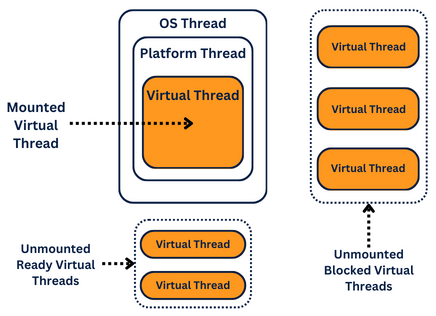Java 21 is here, and it’s going to bring a lot of exciting new things to the world of programming, making it more innovative and productive. This new version, which provides long-term support, comes with many new features and improvements. These are created to help developers to make their work better.
From the groundbreaking introduction of virtual threads to the refined elegance of string templates, Java 21 is brimming with advancements that are sure to captivate the minds of programmers everywhere.
In this blog, we will embark on a journey of exploration, delving into the depths of the new features that Java 21 has to offer. We will unveil the potential of these advancements and showcase how they can be harnessed to create more efficient, performant, and maintainable code.
So, prepare to be amazed as we uncover the gems that lie hidden within the depths of Java 21. Let the journey of discovery begin!
Related read: How To Be A Great App Developer
Java 21 marks a significant milestone in the evolution of the Java language. With a wide variety of new features and enhancements, Java 21 stands as a testament to the continuous effort to refine and improve the language.
In comparison to older versions of Java, Java 21 offers a number of key advantages:
🔸 Enhanced Expressiveness and Clarity: Java 21 introduces a number of features that make code more expressive and clear. For example, record patterns provide a concise and elegant way to deconstruct record values, while string templates allow for the creation of dynamic and expressive strings.
🔸 Increased Flexibility and Control: Java 21 also provides a number of features that give developers greater flexibility and control over their code. For example, the new switch case allows for pattern matching against a variety of values, while virtual threads enable the creation of lightweight threads that can be managed more efficiently.
🔸 Improved Performance and Scalability: Java 21 includes a number of optimizations that can improve the performance and scalability of Java applications. For example, the Shenandoah garbage collector is designed to reduce garbage collection pauses, while the Epsilon garbage collector is designed to improve the performance of applications that allocate a large number of short-lived objects.
In addition to these major features, Java 21 also includes a number of smaller enhancements and bug fixes. These enhancements and bug fixes further improve the quality and reliability of the Java language.
Overall, Java 21 represents a significant step forward in the evolution of the Java language. The new features and enhancements in Java 21 make it a more powerful, expressive, and flexible language that can be used to create more sophisticated and performant applications.
Related read: How to Ensure Quality with Automation
The switch statement has been a fundamental part of the Java language since its beginning. But, with the introduction of Java 21, the switch statement has transformed, becoming a more potent and flexible tool for managing how a program works.
At the heart of the new switch case lies the concept of pattern matching. Pattern matching allows the switch statement to compare the value of an expression against a variety of patterns, rather than just simple equality. This opens up a whole new realm of possibilities for using the switch statement.
For example, the following code snippet demonstrates how the new switch case can be used to match against a range of values:
switch (number) {
case 1..10:
System.out.println("The number is between 1 and 10.");
break;
case 11..20:
System.out.println("The number is between 11 and 20.");
break;
default:
System.out.println("The number is outside the range of 1 to 20.");
}In this example, the number variable is compared against a range of values using the operator. If the value of the number falls within one of the specified ranges, the corresponding code block is executed.
In addition to supporting range matching, the new switch case also supports pattern matching against objects. For example, the following code snippet demonstrates how the new switch case can be used to match against the type of an object:
Object obj = new Object();
switch (obj) {
case String s:
System.out.println("The object is a string.");
break;
case Integer i:
System.out.println("The object is an integer.");
break;
default:
System.out.println("The object is of an unknown type.");
}Java 21 introduces a new feature known as record patterns, which provide a powerful and concise way to deconstruct record values. Record patterns are a natural extension of the existing pattern-matching capabilities in Java, and they offer a number of advantages over traditional methods of data destructuring.
One of the key advantages of record patterns is that they allow for the destructuring of record values in a single statement. For example, the following code snippet demonstrates how to destructure a record value using a record pattern:
record Person(String name, int age) {}
Person person = new Person("John Doe", 42);
switch (person) {
case Person(String name, int age):
System.out.println("Name: " + name);
System.out.println("Age: " + age);
break;
}In this example, the person variable is destructured into its constituent components, name and age. The name and age variables are then available for use within the switch statement.
In addition to being concise, record patterns are also type-safe. This is because the compiler can statically verify that the record value being destructured matches the pattern. This helps to prevent errors and makes the code more robust.
Record patterns can also be used in conjunction with other pattern-matching features in Java. For example, the following code snippet demonstrates how to use a record pattern in conjunction with a type pattern:
switch (obj) {
case Person(String name, int age):
System.out.println("Name: " + name);
System.out.println("Age: " + age);
break;
case instanceof Person person:
System.out.println("Person: " + person);
break;
}In this example, the obj variable is matched against a record pattern. If the match is successful, the name and age variables are destructured from the record value. If the match is not successful, the obj variable is checked to see if it is an instance of the Person class. If the obj variable is an instance of the Person class, the person variable is assigned a reference to the object.
Java 21 introduces a new feature known as string templates, which provide a powerful and flexible way to construct strings. String templates are similar to string literals, but they contain embedded expressions that can be evaluated at runtime. This allows for the creation of dynamic and expressive strings that can be tailored to specific needs.
One of the key advantages of string templates is that they allow for the separation of logic and presentation. This is because the embedded expressions in a string template can be used to perform calculations, format data, and control the flow of logic. This separation of concerns can make code more readable and maintainable.
For example, the following code snippet demonstrates how to use a string template to format a date:
String date = "2023-10-22";
String formattedDate = StringTemplate.of("$date{dd MMM yyyy}", "date", date);
System.out.println(formattedDate); // Prints "22 Oct 2023"In this example, the date variable is passed to the StringTemplate.of() method along with the string template. The string template contains the embedded expression $date{dd MMM yyyy}, which is used to format the date value. The resulting string is assigned to the formattedDate variable.
String templates can also be used to control the flow of logic. For example, the following code snippet demonstrates how to use a string template to create a conditional message:
boolean isLoggedIn = true;
String message = StringTemplate.of("Welcome, $user!", "user", isLoggedIn ? "user" : "guest");
System.out.println(message); // Prints "Welcome, user!"In this example, the isLoggedIn variable is used to determine the value of the user variable. The user variable is then passed to the StringTemplate.of() method along with the string template. The resulting string is assigned to the message variable.
String templates are a powerful and versatile tool that can be used to create dynamic and expressive strings. By leveraging the power of embedded expressions, string templates can be used to simplify and improve the readability of code.
The main method in Java is a special method that is used to start a Java program. In previous versions of Java, the main method had to be public, static, and void. However, in Java 21, the main method can now have public, protected, or default access, can have any return type, and can have any number of parameters.
This change was made to make it easier for beginners to learn Java. It also provides more flexibility for experienced programmers. For example, a programmer could now write a main method that returns a value or a main method that takes a single argument.
The change to the main method is made possible by the introduction of a more flexible launch protocol. This protocol allows the JVM to identify the appropriate main method to start the program, even if it does not meet the traditional requirements.
For example, the following code would be a valid Java program in Java 21:
class Main {
protected void main() {
System.out.println("Hello, world!");
}
}This code would be equivalent to the following traditional Java code:
public class Main {
public static void main(String[] args) {
System.out.println("Hello, world!");
}
}The changes to the main method in Java 21 are a welcome addition to the language. They make Java more beginner-friendly and provide more flexibility for experienced programmers.
In the realm of concurrent programming, threads have long been the go-to tool for achieving parallelism. However, traditional threads come with a number of drawbacks, such as high overhead and limited scalability.
Virtual threads, a new feature introduced in Java 21, aim to address these drawbacks by providing a more lightweight and scalable alternative to traditional threads. Virtual threads are implemented by the Java runtime rather than the operating system.
This means that they can be created and destroyed much more quickly than traditional threads. Additionally, virtual threads can be multiplexed onto a smaller number of operating system threads, which can improve performance and scalability.
One of the key benefits of virtual threads is that they can be used to write blocking code without incurring the performance penalties associated with traditional threads. When a virtual thread blocks, the Java runtime can simply switch to another virtual thread. This allows virtual threads to be used to implement highly concurrent applications without the need for complex asynchronous programming techniques.
For example, the following code snippet demonstrates how to use virtual threads to implement a simple web server:
public class WebServer {
public static void main(String[] args) {
for (int i = 0; i < 1000; i++) {
VirtualThread.create(() -> {
// Handle request
});
}
}
}In this example, 1000 virtual threads are created. Each virtual thread will handle a single request. Because virtual threads are lightweight, they can be created and destroyed very quickly. This allows the webserver to handle a large number of concurrent requests.
Virtual threads are a powerful new tool that can be used to write more performant and scalable concurrent applications. By leveraging the power of virtual threads, developers can achieve a new level of concurrency without the need for complex asynchronous programming techniques.

Java 21 introduces a number of new collection methods that are designed to enhance the efficiency and clarity of code. These new methods provide a more concise and expressive way to perform common collection operations.
These new collection methods provide a more concise and expressive way to perform common collection operations. By using these methods, developers can write more readable and maintainable code.
The following code snippet demonstrates how to use the removeIf() method to remove all even numbers from a list:
<Integer> numbers = Arrays.asList(1, 2, 3, 4, 5); numbers.removeIf(n -> n % 2 == 0); System.out.println(numbers); // Prints [1, 3, 5]
The following code snippet demonstrates how to use the replaceAll() method to replace all elements in a list with their squares:
List<Integer> numbers = Arrays.asList(1, 2, 3, 4, 5); numbers.replaceAll(n -> n * n); System.out.println(numbers); // Prints [1, 4, 9, 16, 25]
The following code snippet demonstrates how to use the merge() method to combine two lists into a single list:
List<Integer> numbers1 = Arrays.asList(1, 2, 3); List<Integer> numbers2 = Arrays.asList(4, 5, 6); List<Integer> mergedNumbers = List.merge(numbers1, numbers2, (a, b) -> a + b); System.out.println(mergedNumbers); // Prints [1, 2, 3, 4, 5, 6]
The following code snippet demonstrates how to use the of() method to create a new list containing the specified elements:
List<String> names = List.of("John", "Mary", "Alice");
System.out.println(names); // Prints [John, Mary, Alice]The following code snippet demonstrates how to use the copyOf() method to create a new list that is a copy of the specified list:
List<String> names = Arrays.asList("John", "Mary", "Alice");
List<String> copyOfNames = List.copyOf(names);
System.out.println(copyOfNames); // Prints [John, Mary, Alice]You can visit my GitHub repository for more information.

In conclusion, the dawn of Java 21 brought a wave of innovation and empowerment to the world of programming. With a multitude of new features and enhancements, this Long Term Support release marks a significant milestone in Java’s evolution. It introduces enhanced expressiveness, clarity, flexibility, and control to the language, making it more powerful and adaptable for developers.
The introduction of virtual threads, string templates, and record patterns paves the way for a new era of programming, offering improved performance and scalability, efficient control flow, and data deconstruction capabilities. The changes in the main method enhance Java’s accessibility and flexibility, catering to both beginners and experienced programmers.
Virtual threads, a novel approach to concurrency, provide a lightweight and scalable solution, reducing the overhead associated with traditional threads. Meanwhile, new collection methods streamline common operations, promoting code efficiency and readability.
Leave your competitors behind! Become an EPIC integration pro, and boost your team's efficiency.
Register Here

The Mindbowser team's professionalism consistently impressed me. Their commitment to quality shone through in every aspect of the project. They truly went the extra mile, ensuring they understood our needs perfectly and were always willing to invest the time to...

CTO, New Day Therapeutics

I collaborated with Mindbowser for several years on a complex SaaS platform project. They took over a partially completed project and successfully transformed it into a fully functional and robust platform. Throughout the entire process, the quality of their work...

President, E.B. Carlson

Mindbowser and team are professional, talented and very responsive. They got us through a challenging situation with our IOT product successfully. They will be our go to dev team going forward.

Founder, Cascada

Amazing team to work with. Very responsive and very skilled in both front and backend engineering. Looking forward to our next project together.

Co-Founder, Emerge

The team is great to work with. Very professional, on task, and efficient.

Founder, PeriopMD

I can not express enough how pleased we are with the whole team. From the first call and meeting, they took our vision and ran with it. Communication was easy and everyone was flexible to our schedule. I’m excited to...

Founder, Seeke

Mindbowser has truly been foundational in my journey from concept to design and onto that final launch phase.

CEO, KickSnap

We had very close go live timeline and Mindbowser team got us live a month before.

CEO, BuyNow WorldWide

If you want a team of great developers, I recommend them for the next project.

Founder, Teach Reach

Mindbowser built both iOS and Android apps for Mindworks, that have stood the test of time. 5 years later they still function quite beautifully. Their team always met their objectives and I'm very happy with the end result. Thank you!

Founder, Mindworks

Mindbowser has delivered a much better quality product than our previous tech vendors. Our product is stable and passed Well Architected Framework Review from AWS.

CEO, PurpleAnt

I am happy to share that we got USD 10k in cloud credits courtesy of our friends at Mindbowser. Thank you Pravin and Ayush, this means a lot to us.

CTO, Shortlist

Mindbowser is one of the reasons that our app is successful. These guys have been a great team.

Founder & CEO, MangoMirror

Kudos for all your hard work and diligence on the Telehealth platform project. You made it possible.

CEO, ThriveHealth

Mindbowser helped us build an awesome iOS app to bring balance to people’s lives.

CEO, SMILINGMIND

They were a very responsive team! Extremely easy to communicate and work with!

Founder & CEO, TotTech

We’ve had very little-to-no hiccups at all—it’s been a really pleasurable experience.

Co-Founder, TEAM8s

Mindbowser was very helpful with explaining the development process and started quickly on the project.

Executive Director of Product Development, Innovation Lab

The greatest benefit we got from Mindbowser is the expertise. Their team has developed apps in all different industries with all types of social proofs.

Co-Founder, Vesica

Mindbowser is professional, efficient and thorough.

Consultant, XPRIZE

Very committed, they create beautiful apps and are very benevolent. They have brilliant Ideas.

Founder, S.T.A.R.S of Wellness

Mindbowser was great; they listened to us a lot and helped us hone in on the actual idea of the app. They had put together fantastic wireframes for us.

Co-Founder, Flat Earth

Ayush was responsive and paired me with the best team member possible, to complete my complex vision and project. Could not be happier.

Founder, Child Life On Call

The team from Mindbowser stayed on task, asked the right questions, and completed the required tasks in a timely fashion! Strong work team!

CEO, SDOH2Health LLC

Mindbowser was easy to work with and hit the ground running, immediately feeling like part of our team.

CEO, Stealth Startup

Mindbowser was an excellent partner in developing my fitness app. They were patient, attentive, & understood my business needs. The end product exceeded my expectations. Thrilled to share it globally.

Owner, Phalanx

Mindbowser's expertise in tech, process & mobile development made them our choice for our app. The team was dedicated to the process & delivered high-quality features on time. They also gave valuable industry advice. Highly recommend them for app development...

Co-Founder, Fox&Fork
